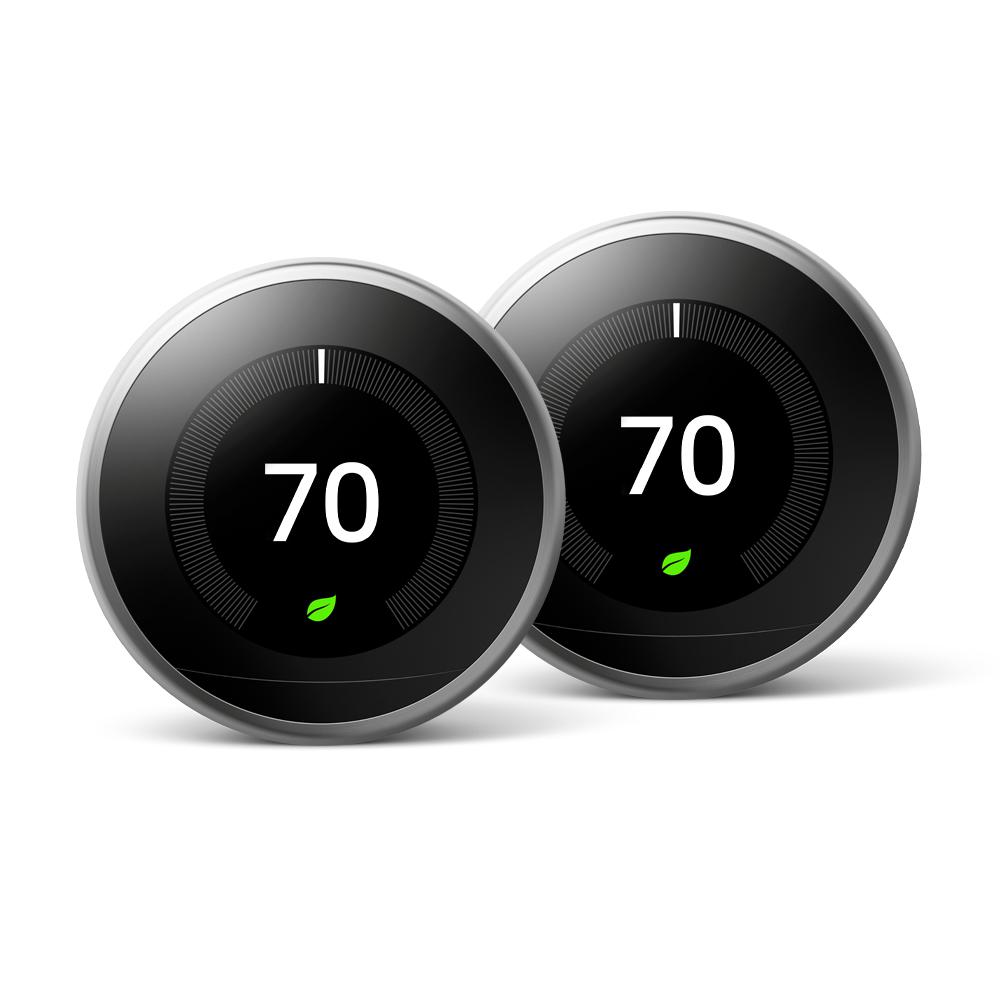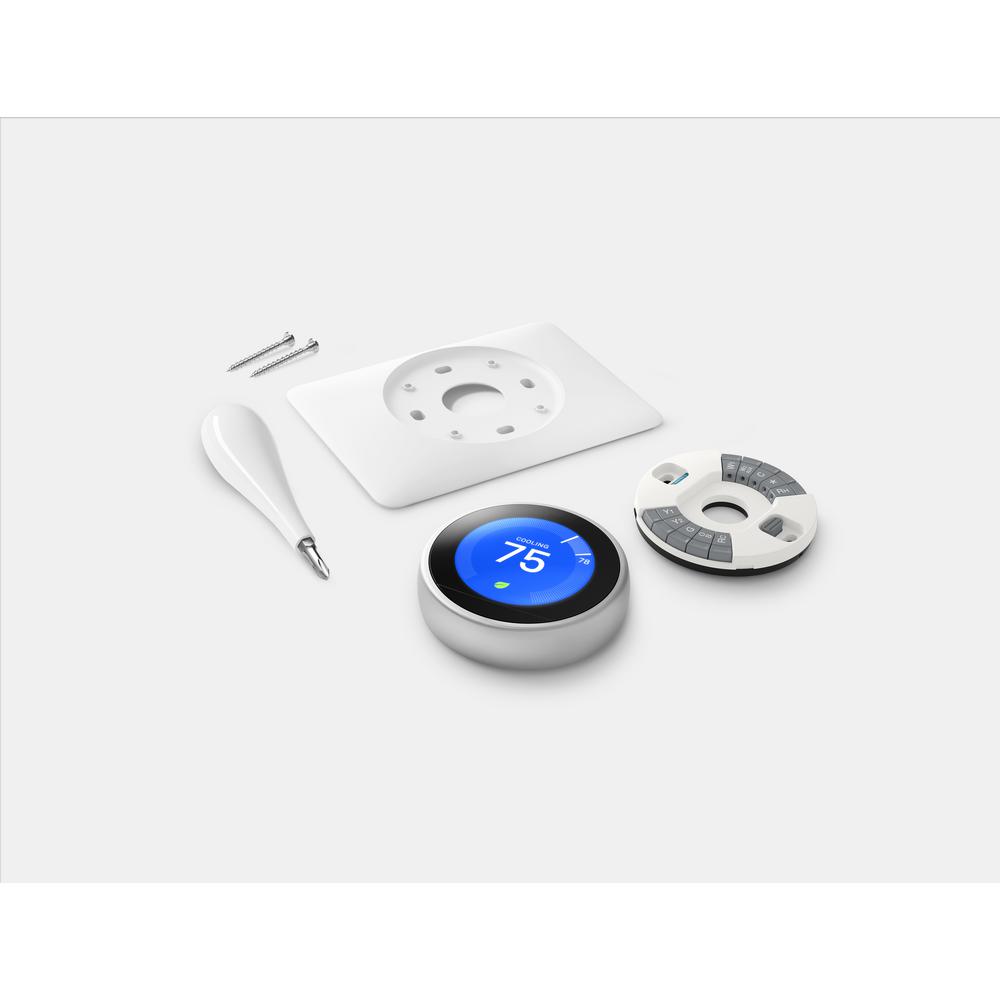Google Nest Learning Thermostat 3rd Gen in Stainless Steel (2-Pack)
Learns your favorite temperature settings and adjusts. Saves on energy bills: up to 12% on heating and 15% on cooling. Control remotely through smart device and set up alerts.
Proven to save energy, the Nest Learning Thermostat is more beautiful than ever, redesigned with a thinner, sleeker design and bigger, sharper display. It saves on average 10 to 12 percent on heating bills and 15 percent on cooling bills, which means it can pay for itself in less than two years. Built to last, enjoy its automatic programming and remote control by linking it to your smartphone or other devices.
- Auto-schedule no more confusing programming, it learns the temperatures you like and programs itself
- Remote control connect the Nest thermostat to Wi-Fi to change the temperature from your phone, tablet or laptop
- Nest leaf you’ll see the leaf when you choose temperature that saves energy, it guides you in the right direction
- Early-on Nest learns how your home warms up and keeps an eye on the weather to get you the temperature you want when you want it
- Auto-away the Nest thermostat automatically turns itself down when you’re away to avoid heating or cooling an empty home
- Energy history: see when heating and cooling were on and what affected your energy use
- Safety alerts get an alert on your phone or tablet if your home gets dangerously hot or cold
- Far sight when Nest thermostat spots you across the room, it lights up beautifully to show you the temperature you’ve set or the time
- Heating and cooling system care: HVAC monitoring looks out for your heating and cooling system to make sure everything’s running smoothly. Alerts can notify you of a potential issue with an eligible HVAC system. They’re meant to provide helpful information, not an endorsement, representation, or warranty of any kind about the health of your HVAC system. Alerts aren’t intended to replace a diagnosis by a qualified HCAV professional.
Additional information
| Display height (in.) | 2.1 |
|---|---|
| Display width (in.) | 2.1 |
| Product Depth (in.) | 1.21 |
| Product Height (in.) | 3.3 |
| Certifications and Listings | UL Listed |
| Manufacturer Warranty | 2 year limited |



by Anne
Sharp design ! Easy to use. I had a problem w the trim kit not fitting my device so I’ll be returning it after my next one comes in . It actually was featured as going together so I trusted that . But oh well that’s life . I’ll be all set this week .
by Fan
This smart thermostat takes one thing off your mind. There are many programmable thermostats out there, but this works with many smart devices and has an app to change temperature. I can set it anywhere if I’m in bed, vacation, or about to head home it lets me have peace of mind for my gas furnace savings. It also can use your location feature on your phone to turn control the thermostat if it being used or not when you are nearby or away from home. I use Alexa and it is easy to program and to setup like a programmable thermostat depending on the season, time, and weather. Doing this the thermostat also can learn your habits and automatically adjust for it. I rarely touch my thermostat now as is it automatic. Pros: Learns your habits, easy of use, app available, programmable, Alexa Google devices enabled, saves money, phone location uses, sleek looking
by James
I’ve used about every generation of the nest thermostats personally and they’ve been rock solid for me. The key is always installing the common wire. Nest stands behind the product and getting replacements for bad units has never been a problem. As a pro installer as well I have nothing bad to say. A lot of hvac techs complain about the product but really it comes down to widespread ignorance in the hvac industry .
by Chilly
I love that it was an easy installation. Please disconnect circuit to thermostat. It is aesthetically pleasing to the eye and easy to read in color. I love the feature of being able to see the weather (outside temperature) and icons for sun, cloudy, rain, etc. More valuable info than setting it on clock. However, my unit will not connect the app to use remotely on my phone. I heard this is an issue; but I didn’t purchase it for that. It will learn when I am not home and adjust the temperature based on my personal settings. Plus, it earns you an rebate from your power company!
by Niceee
I really like this product. Installation was a breeze and it gave my room a nice upgraded look. It wakes up when you walk by it, which is pretty cool, as I sometime use it as a night light. Overall great product.
by Antonio
Great product. Had to return this though because there was a used one in the factory sealed box. Great staff at HD. No hassle returning it but they were sold out of this color so I got another one.
by Maria
The old thermostat didn’t seem to be working properly so we decided to go hi tech with our new purchase. I’m so glad we did. We had a new A/C unit installed in September 2016 and It just didn’t feel as comfortable in the house as I did in the past. This thermostat shows the humidity also which is perfect. You should know what the humidity is in your home. This proved to my husband we have high humidity. I have a repair man coming tomorrow from home depot. We just purchased the Nest thermostat and extra sensor yesterday. But it seems to cycle the airconditioner much better so far. It was easy for my husband to install and I already got back my rebate from the Illuminating company!! Best part I could turn the air conditioner down after I go to bed without getting up!!! The only downside was one of the clips was broken on the unit and my husband had to return the first one. After he had installed all the wires.
by John
The Google nest is a great product! This system controls your temperature in the house through learning your habits. Already my electric bill has gone down. You can also set your own schedule through the Nest app on your phone or your computer. At night if i want a little cooler, i just get my phone and go through the nest app and change it. Easy Peasy! I am also 67 years old woman and installed the Google Nest by myself. I watched their video on YouTube and also read the instructions. Very simple to install. I give Google Nest the highest rating! I also plan on installing the Google Nest Secure for my home security.